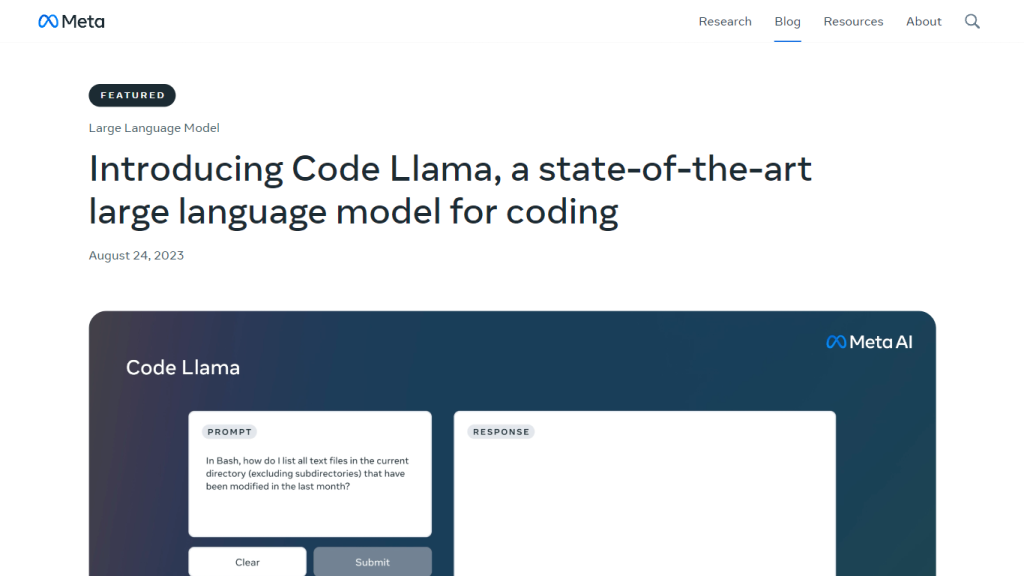What is Code Llama?
Code Llama is a new, advanced large language model, and it was designed for many coding applications. It was built on top of an already robust version called Llama 2; thus, this code llama turns out to be revolutionary for developers in generating code and offering them a wide range of solutions. This state-of-the-art model comes free of charge and has three variants, each tuned for different needs; thus, being efficient and accurate, both for research and commercial needs. Be it code snippet generation, completion, or debugging of any software, Code Llama supports an advanced coding experience that, with its sophisticated natural language understanding, supports a range of popular programming languages.
Key Features & Benefits of Code Llama
Model Sizes: Code Llama is available as models of 7B, 13B, and 34B parameters to suit a wide range of different performance and latency needs.
Fine-Tuning for Code: Specialized variants such as Code Llama – Python and Code Llama – Instruct targeted at Python and instruction-aligned tasks.
More Context: It was trained on as many as 100,000 tokens of context in order to bring in more relevance in code and the ability to debug large codebases.
Benchmarks and Testing: Performs much better than other state-of-the-art language models on coding tasks according to the HumanEval and MBPP benchmarks.
Responsible AI Development: Has in place rigorous safety measures, including but not limited to red teaming effort, in the creation and usage of AI models.
Advantages of using Code Llama: high efficiency in coding, perfect accuracy in generating code, powerful debugging. Unique Selling Proposition includes special fine-tuning for coding tasks and strong emphasis on responsible AI development.
Scenarios and Applications of Code Llama
Following are some of the situations where the use of Code Llama is noticed:
-
Code Generation:
Automatic generation of codes in different programming languages. -
Code Completion:
This will help developers fill in missing code from partial writups, which increases their productivity. -
Debugging:
It identifies errors in the code and provides corrections; hence, it is a lot easier to manage big codebases.
Industries or sectors where Code Llama can be useful include software development, data science, and educational institutions. Indeed, case studies have made it very evident that when using Code Llama, improvements in coding efficiency and accuracy increase significantly.
How to Use Code Llama
Steps to Use Code Llama
- Select the Right Model: Choose models of 7B, 13B, and 34B based on different needs of performance and latency.
- Input Your Code: Provide the initial code or description of the task.
- Code Generation/Code Completion: Generate new code or complete the code using Code Llama.
- Review and Debug: View the generated code and make use of the debugging capabilities in the Code Llama tool.
For best practices, ensure that your instructions are clear and concise. Take some time to explore the user interface, getting familiar with the site’s features and knowing how to navigate through it.
How Code Llama Works
Code Llama works on a strong technical backbone based on the Llama 2 model. It uses special algorithms and models fine-tuned for coding tasks. The workflow includes:
-
Input Processing:
Accepts code snippets or task descriptions as input. -
Model Computation:
It uses the selected model size to compute the given input for code generation. -
Output Generation:
It generates code snippets, code completion, or debugging suggestions in sentences derived from the preprocessed input.
Basically, the core technology and special fine-tuning processes help to understand the efficiency and accuracy of the model.
Code Llama Pros and Cons
Pros:
- Highly accurate code generation and code completion.
- Specialized fine-tuning for better performance on coding aspects.
- Supports multiple popular programming languages.
- Advanced context for large codebases.
Possible Cons:
- Not suitable for general natural language tasks.
- Must have strong hardware to run the most enormous model (34B).
As illustrated in user feedback, model performance is lauded based on increasing programmer productivity but is hindered by intensive computational requirements needed to utilize the larger models.
Conclusion about Code Llama
This tool has really revolutionized the way developers can generate code, complete it, and debug it. Fine-tuned for specificity and the ability to handle multiple programming languages make Code Llama much more ahead in coding tasks. Though there are some limitations concerning general natural language processing, its advantages predominantly overshadow such a drawback. Further development will enhance its capabilities even more and will make it much more useful than today.
Code Llama FAQs
What is Code Llama?
Code Llama is a large language model developed for coding applications that include code generation, completion, and debugging.
Can the Code Llama models be used out of the box for general natural language tasks?
No. Code Llama is fine-tuned for specific coding applications and is not supposed to be used for general natural language applications.
Is Code Llama built on top of another model?
Yes, it is built on top of Llama 2 and further fine-tuned on code-specific datasets.
Which programming languages does the Code Llama support?
It supports such languages as Python, C++, Java, PHP, Typescript, C#, and Bash.
For which tasks should be 7B and 13B Code Llama models be used?
Models 7B and 13B are faster and therefore should be used for low-latency applications like real-time code completion.









